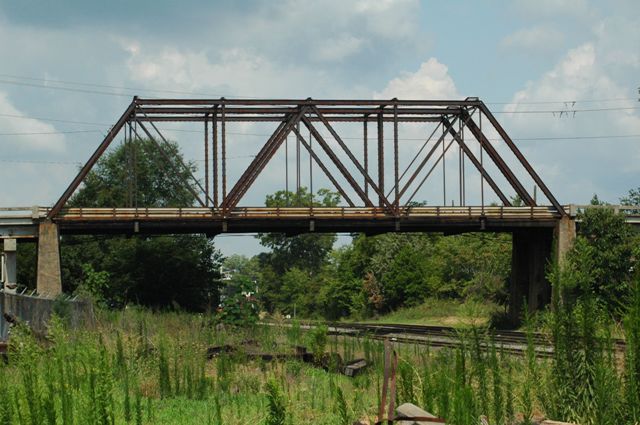We Recommend:
Bach Steel - Experts at historic truss bridge restoration.
BridgeHunter.com Phase 1 is released to the public! - Visit Now
6th Street Bridge

Primary Photographer(s): Dave Michaels
Bridge Documented: July 19, 2007
1912
100.0 Feet (30.5 Meters)
695.0 Feet (211.8 Meters)
27.2 Feet (8.29 Meters)
1 Main Span(s) and 5 Approach Span(s)
25500480

View Information About HSR Ratings
Bridge Documentation
This bridge is in storage!
Bridge Status: This historic bridge has been placed into storage awaiting restoration and reuse in a new location.2022 Update: It is believed the trusses remain in storage at this location: https://goo.gl/maps/tGtuccpPFgbPWAUYA however trees have since grown up around the trusses. This is a shame as the bridge should be reused and preserved somewhere, and in the meantime trees should be kept from growing up through the trusses.
View Archived National Bridge Inventory Report - Has Additional Details and Evaluation
Georgia has very few metal truss bridges, and as such, a bridge like this one, which would stand out in the most truss-rich state in the country, is so rare and significant that it might be the most important historic bridge in the entire state. The central reason for its rarity is the truss configuration of this bridge, that of a pin-connected Warren truss bridge, it a form that is extremely rare. Nearly all surviving Warren truss bridges have riveted connections. The bridge is also significant as an earlier pin-connected railroad truss bridge. Most pin-connected truss bridges from the 1880s or earlier were destroyed by the early 20th Century due to increases in weight of trains. This bridge appears to date to ca 1888 and was originally built at an unknown location to serve trains. It most likely was a "normally" configured two-span bridge since the single span, double truss configuration as seen on the road today would not have been needed for a train. It was relocated and erected in its current site in 1912. In 1958, wooden stringer approach spans were replaced with the steel stringers present today. Portions of the bottom chord and connections were encased in concrete and asphalt an alteration that has recently been partially removed at the connection points.
The bridge is unusual because it is two independent truss spans sitting side by side on a shared substructure to form a single two lane bridge. This is different from some wide truss bridges that have three truss lines, with one line in the center. The center of this bridge has two independent truss lines yielding a total of four truss lines.
The bridge also displays distinctive/unusual design details. The orientation of the sway bracing is such that the v-lacing is on the top and bottom of the built up beams. Usually with sway bracing of this design, the v-lacing/lattice is on the sides of the beam. The first section of bottom chord extends from the end post across two panels before it is connected to a vertical member. In other words, it is not connected to the hip vertical which is unusual. The pedimented portal bracing and the design of its associated knee bracing is both uncommon and beautiful.
The pin-connected Warren truss bridge is a good teaching bridge because pin-connected truss bridges typically display eyebars for tension members and built-up beams for compression members, which allows viewers to see which members in a Warren truss contain tension and which contain compression. Warren truss diagonal members alternate between tension and compression, although the two central diagonals are often in compression or they experience minimal forces.
There are plans to replace this bridge, but the historic truss spans are to be carefully marked, disassembled and stored for future restoration and re-erection.
![]()
Photo Galleries and Videos: 6th Street Bridge
Bridge Photo-Documentation
Original / Full Size PhotosA collection of overview and detail photos. This gallery offers photos in the highest available resolution and file size in a touch-friendly popup viewer.
Alternatively, Browse Without Using Viewer
![]()
Bridge Photo-Documentation
Mobile Optimized PhotosA collection of overview and detail photos. This gallery features data-friendly, fast-loading photos in a touch-friendly popup viewer.
Alternatively, Browse Without Using Viewer
![]()
Maps and Links: 6th Street Bridge
Coordinates (Latitude, Longitude):
Search For Additional Bridge Listings:
Bridgehunter.com: View listed bridges within 0.5 miles (0.8 kilometers) of this bridge.
Bridgehunter.com: View listed bridges within 10 miles (16 kilometers) of this bridge.
Additional Maps:
Google Streetview (If Available)
GeoHack (Additional Links and Coordinates)
Apple Maps (Via DuckDuckGo Search)
Apple Maps (Apple devices only)
Android: Open Location In Your Map or GPS App
Flickr Gallery (Find Nearby Photos)
Wikimedia Commons (Find Nearby Photos)
Directions Via Sygic For Android
Directions Via Sygic For iOS and Android Dolphin Browser
USGS National Map (United States Only)
Historical USGS Topo Maps (United States Only)
Historic Aerials (United States Only)
CalTopo Maps (United States Only)

